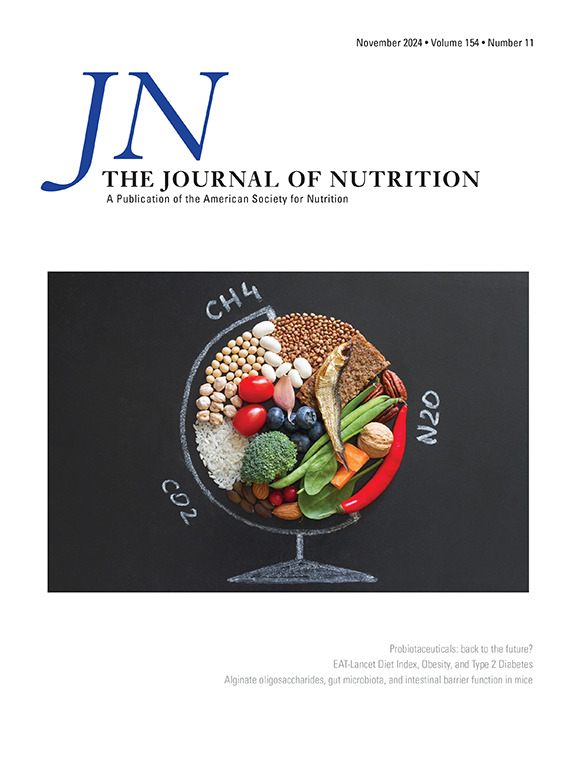食用富含鸡蛋的膳食和建立每天添加一个鸡蛋的模型可降低美国青少年营养不足的风险,无论他们是否存在粮食不安全问题。
IF 3.7
3区 医学
Q2 NUTRITION & DIETETICS
引用次数: 0
摘要
背景:在人的一生中,青少年的膳食摄入量最差。粮食不安全加剧了这些营养风险。目标:1)比较通常营养素摄入量、膳食营养素参考摄入量和蛋白质摄入量是否符合建议,以及微量营养素质量评分;2)根据食品安全状况和富含鸡蛋的膳食,分析增加一个鸡蛋对青少年营养概况的影响:方法:分析了 2007-2018 年 NHANES 中美国青少年的膳食数据(14-17 岁;n=3,633)。富含鸡蛋的饮食水平分为:1)非鸡蛋;2)作为菜肴配料的鸡蛋;或 3)以鸡蛋为主的菜肴。食品安全状况采用美国家庭食品安全调查模块进行分类。采用美国国家癌症研究所的方法估算通常的营养素摄入量和营养素暴露分数(即食物营养素指数和总营养素指数)。一个中等大小鸡蛋中的营养素含量以现有摄入量为模型。配对 t 检验确定显著差异:结果:无论食品安全状况如何,60%以上的青少年有可能摄入钙、胆碱、镁、维生素 D 和 E 不足。食品安全青少年主要食用蛋类菜肴,其叶黄素+玉米黄质(1544.1微克)、胆碱(408.4毫克)、维生素B2(2.3毫克)、硒(128.6微克)、维生素D(6微克)、二十二碳六烯酸(70毫克)和蛋白质(89.1克)的平均平时摄入量高于其他组别(结论:食品安全青少年的营养摄入量不足,可能会对他们的健康造成严重影响:青少年面临着巨大的营养风险,而粮食不安全和食用鸡蛋较少又加剧了这一风险。本文章由计算机程序翻译,如有差异,请以英文原文为准。
Eating Egg-Rich Diets and Modeling the Addition of One Daily Egg Reduced Risk of Nutrient Inadequacy among United States Adolescents with and without Food Insecurity
Background
Adolescents have the poorest dietary intake throughout their lifespan. Food insecurity worsens these nutritional risks. Eggs are a nutrient-dense strategy to increase nutrient quality.
Objectives
1) compare usual nutrient intakes, Dietary Reference Intake and protein compliance with recommendations and scores of micronutrient quality; and 2) analyze how adding 1 egg affects adolescents’ nutrient profiles, by food security status and egg-rich diets.
Methods
Dietary data of United States adolescents in the 2007–2018 National Health and Nutrition Examination Survey were analyzed (14–17 y; n = 3633). Egg-rich diet levels were categorized as 1) no eggs, 2) eggs as ingredients in dishes, or 3) primarily egg dishes. Food security status was classified using the United States Household Food Security Survey Module. The National Cancer Institute method was used to estimate usual nutrient intake and nutrient exposure scores [i.e., Food Nutrient Index (FNI) and Total Nutrient Index (TNI)]. Nutrient amounts from 1 medium egg were modeled on existing intakes. Pairwise t-tests determined significant differences.
Results
Over 60% of adolescents risked inadequate intake of calcium, choline, magnesium, vitamin D, and vitamin E regardless of food security status. Food-secure adolescents consuming primarily egg dishes had higher mean usual intakes of lutein + zeaxanthin (1544.1 μg), choline (408.4 mg), vitamin B2 (2.3 mg), selenium (128.6 μg), vitamin D (6 μg), docosahexaenoic acid (70 mg), and protein (89.1 g) than other groups (P < 0.0002). Those who were food secure and consuming eggs as ingredients in dishes demonstrated higher nutrient adequacy for magnesium (scored ∼66 out of 100), potassium (scored 81), and total scores (scored 72 and 69, respectively) for the TNI and FNI; and folate only (scored 92) for the TNI, than those who were food insecure and not consuming eggs (P < 0.0002). Adding 1 egg increased choline and vitamin D usual intakes for some groups and nutrient index scores for all groups (P < 0.0005).
Conclusions
Adolescents are at substantial nutritional risk that was exacerbated by food insecurity and less egg consumption.
求助全文
通过发布文献求助,成功后即可免费获取论文全文。
去求助
来源期刊

Journal of Nutrition
医学-营养学
CiteScore
7.60
自引率
4.80%
发文量
260
审稿时长
39 days
期刊介绍:
The Journal of Nutrition (JN/J Nutr) publishes peer-reviewed original research papers covering all aspects of experimental nutrition in humans and other animal species; special articles such as reviews and biographies of prominent nutrition scientists; and issues, opinions, and commentaries on controversial issues in nutrition. Supplements are frequently published to provide extended discussion of topics of special interest.
 求助内容:
求助内容: 应助结果提醒方式:
应助结果提醒方式:


